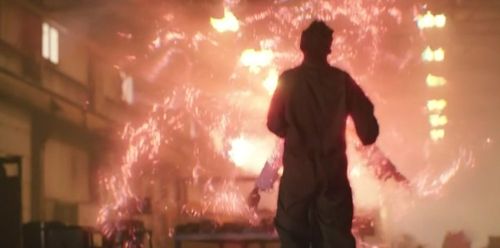Developed for TV by Travis Fickett and Terry
Matalas
546 minutes (15) 2016
Widescreen ratio 16:9
Universal DVD Region 2
Rating: 8/10
Review by Steven Hampton
“Do you believe in fate?” Intriguing sci-fi series 12 Monkeys wraps the timeline crises of
TV shows like Continuum, and the TimeCop movie franchise, around the
portable enigma of Terry Gilliam’s puzzler Twelve
Monkeys (1995). Its curious pedigree includes riffs and references to Chris
Marker’s experimental production, La
Jetee (1962), an over-praised art-house movie with very little actually
motion because it’s basically just a montage of still photos. As if the paradox
of time-travel is not enough of a tangled plot, this drama weaves a layered
conspiracy in the century-spanning mystery of what or who caused the apocalypse.
Dr Cassie Railly (Amanda Schull) wants to warn the world and plan
for a global pandemic, especially after she is told that in the near-future a terrible
plague wipes out most of the population. The origin of the virus is traced to
secret experiments in bio-labs called the Night Room. The controller of
time-travel in 2043, German scientist Jones (Barbara Sukowa) scours news
archives for clues about suspected terrorists known only as the 12 Monkeys.
The debut episode of season one borrows the ‘long
second’ time-freeze from low-budget classic Trancers (1984). Other episodes
include homage scenes to Terminator movies. A cascade of wrong place and wrong
time mistakes put bold traveller Cole (Aaron Standford) in North Korea
The plot-line and main players are rightly paranoid about
many paradoxical changes that might invalidate cause and effect. Tick-tock is
not always progressive here. When a solution to the main monkey business is to
rewrite history, “I told you so” is not an option. Conflicts arise when a time-travel
mission is opposed by another group trying to find a cure with quarantine camps
under martial control, instead of preventing the original outbreak. It becomes
a worthy case of preserving hope versus taking radical action for salvation.
“The dark time must be sacrificed to restore a
brighter one.”
Somewhat
perversely, season one’s climactic sequence happens further in the past than
anything else, when pivotal events affecting Cole and his buddy Ramse occur in
a Tokyo
Madhouse
maiden Jennifer (Emily Hampshire) conceals her emotional fragility beneath her
noisy mask of crazy-bitch banter. “Maybe your always and my always are not the
same.” There are plenty more fascinating twists as timeline detailing is
revealed like a top secrets plot. Or, perhaps, unravelled like a faulty scheme
or a flawed master-plan. The blonde heroine’s overly possessive boyfriend Aaron Marker (the franchise’s notable
name-check) keeps on promising to save Cassie from herself, whether
she wants his help or not.
“You cannot run from fate.” Season Two goes back and forth
again, with Cole stuck in 2016, Budapest, while Cassie
is held captive in 2043, where Dr Jones fails to stop the religious cult of
Messengers from taking control of her time machine. This eventually results in
her shifting over to another timeline: “You were not part of my original
reality,” she tells her new husband.
In New
York
Like in Sliders
(1995 - 2000), a hotel is the frequently used rendezvous point in several
time-zones and eras. There’s also a magical house in the red-tinged surreality
of a red forest dream-scape that’s a link to an even stranger puzzle of time-stream
consciousness and the much-talked-about Witness, who seems like a muse for some
but is a menace to others. The time-fractured house is a building with a
similar narrative function as unusual character, like the barn in TV series Haven (2010-5).
A mission to 1975 has our heroes prevent a murder
they were not supposed to, and so doing something good seems just as likely to
disrupt timelines as doing something nasty. This avoids the spoofy appeal of Life On Mars (2006-7), and/ or Ashes To Ashes (2008-10). With its
dooms-days plot and 'Witness' antagonist, borrowings from the classic movie Timescape (aka: Grand Tour: Disaster In Time, 1992) are inevitable.
Changeable alliances and variable motivations mean
that some characters act like loyal sidekicks and eccentric stereotypes, but often
reveal far greater depths - and not just a revenge for any betrayal - than we
imagined when they appear or re-appear in different timeline plot-twists. With
prodigal sons and resurrected daughters, awkward silences and tragic shoot-outs
are happening now, soon, or back then, as the plot-line extends to span a
hundred years of discontinuity.
This
season, Jennifer is especially good fun whenever she’s quoting (sometimes
cheesy) movie dialogues to hilariously motivational effect. Prompted by Madeleine
Stowe’s guest appearance, Cole quits his rural idyll with pregnant Cassie in
1959 for a trippy pilgrimage through decades (like Billy Pilgrim in Slaughterhouse Five, 1972). Of course,
there is yet another cliff-hanger ending, tantalising us with possibilities for
season three. “The Witness has spoken.”









No comments:
Post a Comment